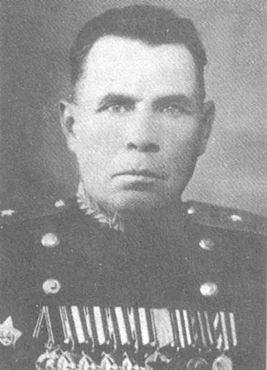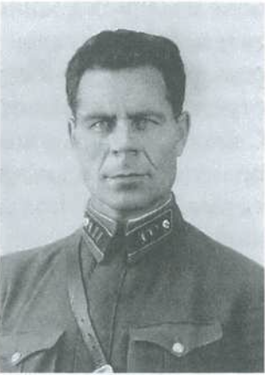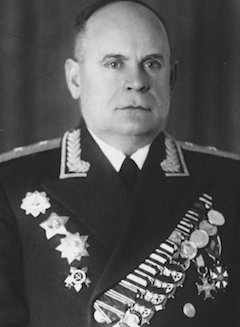Related Research Articles

The Battles of Rzhev were a series of Red Army offensives against the Wehrmacht between 8 January 1942 and 31 March 1943, on the Eastern Front of World War II. The battles took place in the northeast of Smolensk Oblast and the south of Tver Oblast, in and around the salient surrounding Rzhev. Due to the high losses suffered by the Soviet Army, the campaign became known by veterans and historians as the "Rzhev Meat Grinder".

Stanislav Gilyarovich Poplavsky was a general in the Soviet and Polish armies.

The 29th Army is a field army of the Russian Ground Forces and previously the Soviet Army.

The 20th Army was a field army of the Red Army that fought on the Eastern Front during World War II.
The 11th Cavalry Corps of the Soviet Union's Red Army was a cavalry corps active during the Second World War.
The 39th Army was a Field Army of the Soviet Union's Red Army during World War II and of the Soviet Army during the Cold War.
The 24th Army was a field army of the Soviet Union's Red Army, formed in 1941 and active during the Second World War. The army was disbanded and reformed a number of times during the war.
The 31st Army was a field army of the Red Army during the Second World War.

The 251st Rifle Division was the seventh of a group of 10 regular rifle divisions formed from cadres of NKVD border and internal troops as standard Red Army rifle divisions, very shortly after the German invasion, in the Moscow Military District. It was largely based on what would become the shtat of July 29, 1941, with several variations. It served under command of 30th Army in an effort to recover Smolensk in late July and in the Dukhovshchina offensives in August and September, and was quickly reduced to a much-weakened state. It was largely encircled in the initial stages of Operation Typhoon but sufficient men and equipment escaped that it was spared being disbanded. In the following two and a half years the division slogged through the difficult and costly battles around Rzhev and Smolensk as part of 20th Army, and later 31st Army, of Western Front, including several abortive offensives toward Orsha and Vitebsk in late 1943 and early 1944. At the start of Operation Bagration in June the 251st was serving in the 39th Army of 1st Baltic Front and it won a battle honor for its part in the liberation of Vitebsk. Following this victory it advanced into the "Baltic Gap" that had formed between Army Groups North and Center, entering Lithuania and winning the Order of the Red Banner for its part in the fighting for Kaunas. The division was transferred to 43rd Army and then 4th Shock Army as the Front advanced on Riga, and two of its rifle regiments received decorations for the battles for the Latvian capital. In the first days of 1945 the 251st was reassigned yet again, to the 2nd Guards Army of 3rd Belorussian Front, and served under this Army for the duration of the war. It, and several of its subunits, received awards during the East Prussian campaign, and ended the war in East Prussia. After the war the 251st was moved into the Caucasus region, and was finally disbanded in early 1947.

The 252nd Rifle Division was the eighth of a group of 10 regular rifle divisions formed from cadres of NKVD border and internal troops as standard Red Army rifle divisions, very shortly after the German invasion, in the Moscow Military District.
The 250th Rifle Division was the sixth of a group of 10 regular rifle divisions formed from cadres of NKVD border and internal troops as standard Red Army rifle divisions, very shortly after the German invasion, in the Moscow Military District. It was largely based on what would become the shtat of July 29, 1941, with several variations. It served under command of 30th Army in an effort to recover Smolensk in late July and in the Dukhovshchina offensives in August and September, and was quickly reduced to a much-weakened state. It was largely encircled in the initial stages of Operation Typhoon but sufficient men and equipment escaped that it was spared being disbanded and, in fact, it was partly rebuilt by incorporating remnants of other disbanded divisions. In October it played a relatively minor role in the defensive operations around Kalinin as part of 22nd Army in Kalinin Front. Early in 1942 the 250th was transferred to the 53rd Army of Northwestern Front, and spent most of the year rebuilding while also containing the German forces in the Demyansk Pocket. After this position was evacuated at the end of February, 1943 the division was transferred to the Reserve of the Supreme High Command and shipped south, joining the 2nd Reserve Army in Steppe Military District. This soon became the 63rd Army in Bryansk Front and the 250th was assigned to the 35th Rifle Corps, where it remained for the duration of the war. During the summer offensive against the German-held salient around Oryol the division helped lead the drive to liberate that city in August, and then advanced through western Russia and into Belarus, now in Central Front. In the initial phase of Operation Bagration the division, now in 3rd Army, was given special recognition for its role in the liberation of the city of Babruysk, and shortly thereafter also received the Order of the Red Banner and the Order of Suvorov. During 1945 it moved, with its Corps and Army, from 2nd Belorussian to 3rd Belorussian Front before returning to 1st Belorussian, seeing combat in Poland, East Prussia and central Germany; its subunits were awarded additional honors and decorations during this period. The 250th had a distinguished career as a combat unit, ending its combat path along the Elbe River. It was disbanded in Belarus in July 1946.
The 243rd Rifle Division was the first of a group of 10 regular rifle divisions formed from cadres of NKVD border and internal troops as standard Red Army rifle divisions, very shortly after the German invasion, in the Moscow Military District. It was largely based on what would become the shtat of July 29, 1941, with several variations. It served as part of 29th Army in the heavy fighting around Smolensk in July and August, then later in the counteroffensive operations around Kalinin, where it helped to clear the first Soviet territory to be permanently liberated. It then saw extensive service in the severe fighting around Rzhev, before being moved south in the winter of 1942-43. During Operation Gallop in February, as part of 3rd Guards Army, it participated in the action that liberated the city of Voroshilovgrad, before attacking into the Donbas during the following summer. In February of 1944 the division was recognized for its role in the liberation of Nikopol, receiving that place name as an honorific, and then was decorated with the Order of the Red Banner after helping to free Odesa. In May it was trapped by German counterattacks in a deep bend on the east bank of the Dniestr River north of Grigoriopol while serving with 5th Shock Army and suffered heavy losses in breaking out to friendly territory. After recovering from this debacle the 243rd advanced into Romania and Hungary, mostly under either 53rd or 7th Guards Armies, and during early 1945 fought through Czechoslovakia; two of its regiments were decorated for their roles in the liberation of Brno just weeks before the German surrender. Along with the rest of 53rd Army it was railed across Siberia to take part in the Soviet offensive against the Japanese forces in Manchuria in August. While the division saw little, if any, actual combat in the far east, it received a second honorific for the sheer accomplishment of advancing through the mountainous terrain. Within months of the Japanese surrender the 243rd was disbanded.

German Fyodorovich Tarasov was a Red Army major general during World War II.
The 365th Rifle Division began forming on 1 September 1941, as a standard Red Army rifle division, in the Sverdlovsk Oblast. After forming, it was assigned to the 30th Army of Western Front, served briefly in the defense of Moscow, and played a role in the liberation of Klin, and later in the near-encirclement of the German 9th Army around Rzhev in the winter counteroffensive of 1941–42. In late January 1942, it was transferred to the 29th Army of Kalinin Front, which was very soon after encircled by German forces near Sychevka, and on 18 March the division was disbanded due to very heavy losses. In November 1944, a new 365th Rifle Division was formed in the Far Eastern Front, based on the 29th Rifle Brigade, and saw action in the Soviet invasion of Manchuria in August 1945, being awarded the Order of the Red Banner for its services.

Alexander Stepanovich Kostitsyn was a Red Army major general killed during World War II.

Karp Vasilyevich Sviridov was a Soviet Army lieutenant general and a Hero of the Soviet Union.
The 379th Rifle Division was raised in 1941 as an infantry division of the Red Army, and served for the duration of the Great Patriotic War in that role. It began forming in August 1941 in the Urals Military District. It first served in the winter counteroffensive west of Moscow, and later in the bitter fighting around the Rzhev salient, but was moved north late in 1942. It took up positions along the Volkhov River, mostly under command of the 8th Army, and continued to serve in this Army's battles near Leningrad until September 1943, when it was transferred to the 2nd Baltic Front, where it would stay for the remainder of its service. During this period the division served under many army and corps commands but mostly in the 3rd Shock Army. The division ended the war in Lithuania, helping to contain and reduce the German forces trapped in the Courland Pocket. By this time it was judged as being surplus to the Red Army's needs and in December 1944 its personnel were merged with the 245th Rifle Division to bring that division closer to establishment strength; the latter division also inherited its battle honor. The 379th was officially disbanded on the first day of 1945.

Viktor Kazimirovich Urbanovich was a Belarusian Soviet Army lieutenant general.

Vasily Alexandrovich Yushkevich was a Soviet Army colonel general.
The 247th Rifle Division was the fourth of a group of 10 regular rifle divisions formed from cadres of NKVD border and internal troops as standard Red Army rifle divisions, very shortly after the German invasion, in the Moscow Military District. It was largely based on what would become the shtat of July 29, 1941, with several variations. It was assigned to 31st Army, where it remained throughout its existence. As part of Reserve Front, the division, with its Army, was mostly involved in constructing rear-area defenses until the start of Operation Typhoon, becoming encircled in early October. Many of those who survived the breakout were incorporated into the 250th Rifle Division and the 247th was disbanded.
References
- ↑ Sbornik Boevych Dokumentov Vielikoj Otczestviennoj Voiny wypisk 37 Prikaz Stawki Wierchnovo Komandowania nr 00305 ot 13 Julia 1941 o Sformirovaniu 30 Armii i jej zadaczach page 26
- ↑ Fugate Bryan, Lev Dvoriecki Blitzkrieg nad Dnieprem Bellona 2001 page 143
- ↑ Combat composition of the Soviet Army, 1 March 1942
- 1 2 3 Vielikaja Otcczestvennaja Diestvuszowaja Armija 1941 -1945 Animi Fortitudi Moscow 2005 Kuchkovo Pole page 96-97